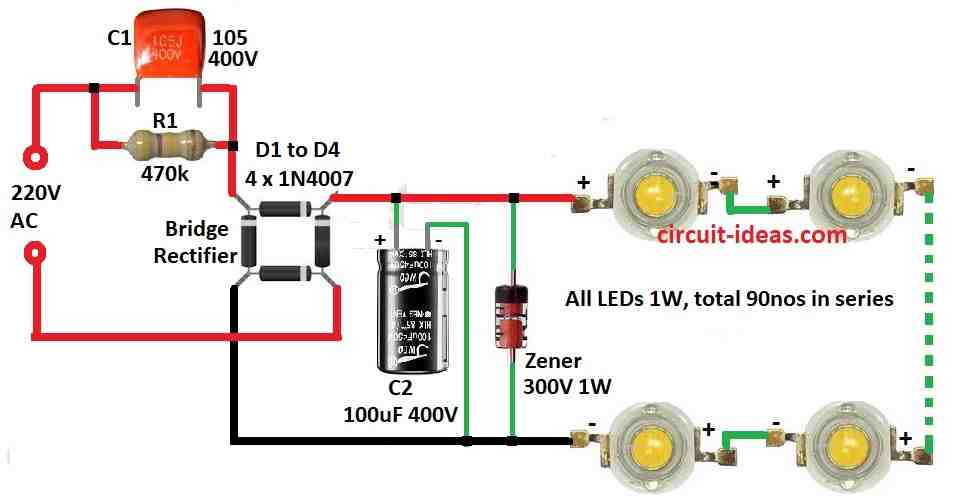This Simple 220V White LED Flood Light Circuit is like a small power machine for big bright light.
It takes normal home current 220V and make those special white LEDs glow.
The circuit works like converter and change big voltage to small one which are good for LEDs.
Inside small parts like resistors, capacitors and diodes, they work like tiny switch and storage for electricity.
All together they make strong white light come out and make place very bright.
But be careful working with 220V is not safe.
No try to build or fix these circuits if one is not having proper training or knowledge.
Circuit Working:

Parts List:
| Category | Component | Quantity | Notes |
|---|---|---|---|
| Resistor | 470k 1/4 watt | 1 | |
| Capacitors | PPC 105 400V | 1 | |
| Electrolytic 100µF 400V | 1 | ||
| Semiconductors | Bridge Rectifier 1N4007 | 4 | |
| Zener diode 300V 1W | 1 | ||
| LEDs 3.3V 1W 300mA | 90 |
This white LED floodlight make porch very bright with cool white light.
The circuit is simple and save energy.
It connect straight to AC power with no need of big transformer.
Now ultra white LEDs take place of tube lights because they save power and are easy to use.
White LEDs give strong light from 10,000 to 60,000 MCD.
They work fine on 3V and 300mA.
LEDs come in spotlight and wide light type.
Common size is 3mm, 5mm and 10mm.
Big power single white LEDs also one can find.
White LEDs first started in 1990.
They are made by using Indium Gallium Nitride and inside it is blue chip and white phosphor.
Blue light hit phosphor then it become white light.
This circuit use capacitor to drop high AC voltage to low and so that heat does not lose much power
C1 drop voltage to around 100V and then D1 to D4 change AC to DC (rectifier).
C2 clean the DC and work like buffer.
Zener diode keep voltage at 69V and stop reverse voltage from hurting LEDs.
R1 is very important as It empties the C1 capacitor after unplug.
If R1 is not used then C1 keep more than 400V for long time which can give big shock!
There are 90 LEDs in series which are bright like 100W CFL bulb.
Put all circuit in safe box but remember do not touch.
One can put shiny reflector behind LEDs to make light spread more.
Important! do not touch anything or try to fix when circuit is connected to power.
Be careful as the circuit runs on AC power which is very dangerous and can give deadly shock if not handle right.
Please do not try to make this circuit if anyone is not sure how to work with high voltage.
Formula:
Value of AC capacitor can be found using this formula:
Xc = 1 / (2πfC)
where,
- Xc means resistance in ohms Ω that capacitor gives to AC current.
- Capacitor are not like resistor.
- Resistor waste energy as heat.
- But capacitor store and release energy at every AC cycle.
Now breaking down the formula:
1 / (2πfC) this show how much capacitor stops the current.
2π is math number which is about 6.28.
f is frequency of AC, how many times current change direction in one second means in Hertz Hz.
C is value of capacitor in Farads F which tell how much energy capacitor can hold.
How it work:
When frequency (f) is high then current change direction fast.
Capacitor cannot store and release fast so Xc goes up with more resistance.
When capacitance C is big then capacitor can hold more energy, so Xc goes down with less resistance and current can flow easier.
So bigger capacitor = easier current flow.
Higher frequency = harder for capacitor to keep up.
How to Build:
To build a Simple 220V White LED Flood light Circuit following steps are required to be followed:
Safety First:
- Always unplug circuit from power before touching or working on it.
- Use tools with plastic handles and put circuit in shockproof box.
Circuit Design:
- Look at the circuit diagram to know where each wire and part should be connected.
Component Assembly:
- Solder all parts like in the diagram.
- Put 90 LEDs in series and then connect them to the rest of the circuit.
Rectification:
- Use 4 diodes D1 to D4 to make bridge rectifier which changes AC to DC.
- Add capacitor C2 to make DC smooth.
Voltage Regulation:
- Put Zener diode to keep voltage at 69V and stop reverse voltage from hurting LEDs.
Safety Resistor:
- Add resistor R1 to empty stored electricity from C1 after unplug this will stop shock risk.
Enclosure:
- Put whole circuit inside shockproof box.
- One can add reflector behind LEDs to make light spread more like floodlight.
- Before plugging into power check all parts and wires again.
- Use multimeter to test and be sure everything is okay.
Connection:
- If all looks good then plug into mains.
- Watch the circuit and if anything strange happens then unplug right away.
Important Note:
- This is simple guide only.
- One needs to know about electronics and safety.
- If not sure better ask trained electrician for help.
Conclusion:
To conclude Simple 220V White LED Flood Light Circuit change high AC power into bright light.
It gives strong and energy saving light, which is good for many uses.
References:
Fabrication of LED Flood Light From Recycle Material with High Quality
Leave a Reply